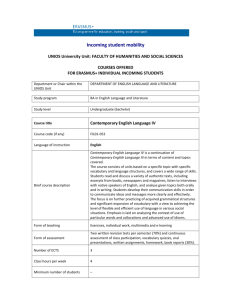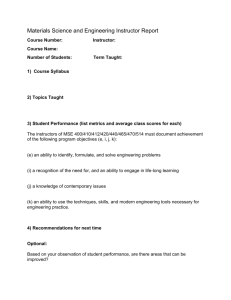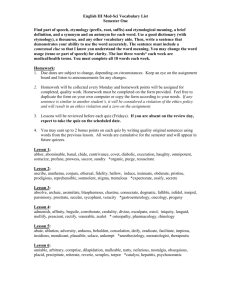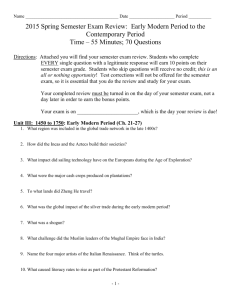SCHOOL OF ART, Division of Art History
advertisement
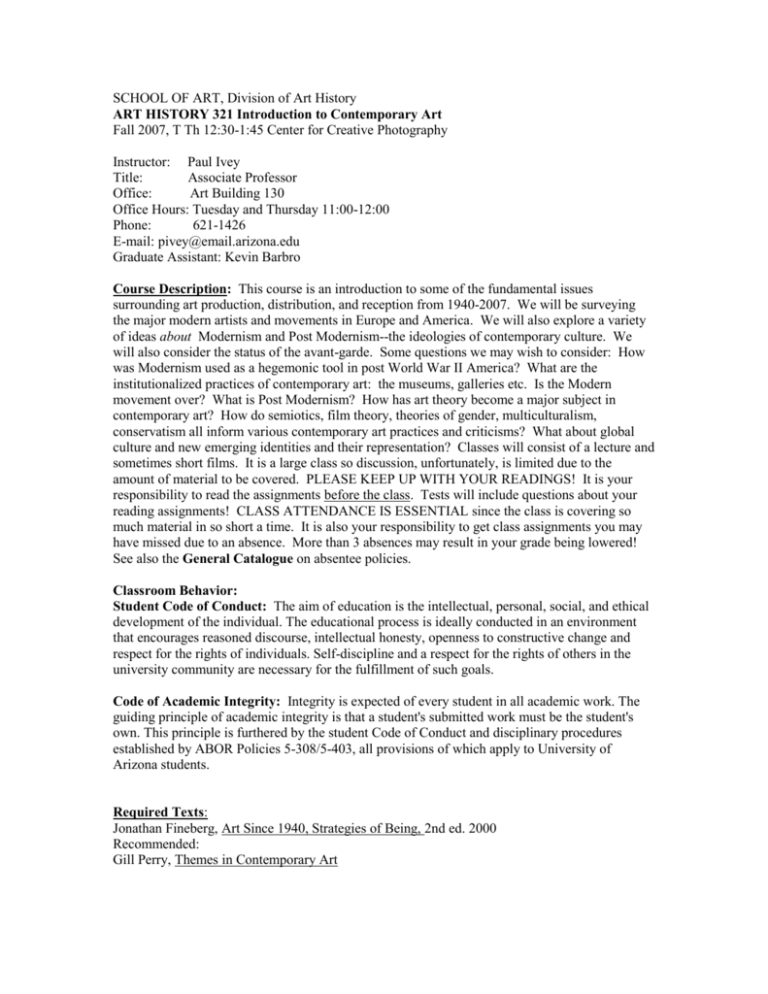
SCHOOL OF ART, Division of Art History ART HISTORY 321 Introduction to Contemporary Art Fall 2007, T Th 12:30-1:45 Center for Creative Photography Instructor: Paul Ivey Title: Associate Professor Office: Art Building 130 Office Hours: Tuesday and Thursday 11:00-12:00 Phone: 621-1426 E-mail: pivey@email.arizona.edu Graduate Assistant: Kevin Barbro Course Description: This course is an introduction to some of the fundamental issues surrounding art production, distribution, and reception from 1940-2007. We will be surveying the major modern artists and movements in Europe and America. We will also explore a variety of ideas about Modernism and Post Modernism--the ideologies of contemporary culture. We will also consider the status of the avant-garde. Some questions we may wish to consider: How was Modernism used as a hegemonic tool in post World War II America? What are the institutionalized practices of contemporary art: the museums, galleries etc. Is the Modern movement over? What is Post Modernism? How has art theory become a major subject in contemporary art? How do semiotics, film theory, theories of gender, multiculturalism, conservatism all inform various contemporary art practices and criticisms? What about global culture and new emerging identities and their representation? Classes will consist of a lecture and sometimes short films. It is a large class so discussion, unfortunately, is limited due to the amount of material to be covered. PLEASE KEEP UP WITH YOUR READINGS! It is your responsibility to read the assignments before the class. Tests will include questions about your reading assignments! CLASS ATTENDANCE IS ESSENTIAL since the class is covering so much material in so short a time. It is also your responsibility to get class assignments you may have missed due to an absence. More than 3 absences may result in your grade being lowered! See also the General Catalogue on absentee policies. Classroom Behavior: Student Code of Conduct: The aim of education is the intellectual, personal, social, and ethical development of the individual. The educational process is ideally conducted in an environment that encourages reasoned discourse, intellectual honesty, openness to constructive change and respect for the rights of individuals. Self-discipline and a respect for the rights of others in the university community are necessary for the fulfillment of such goals. Code of Academic Integrity: Integrity is expected of every student in all academic work. The guiding principle of academic integrity is that a student's submitted work must be the student's own. This principle is furthered by the student Code of Conduct and disciplinary procedures established by ABOR Policies 5-308/5-403, all provisions of which apply to University of Arizona students. Required Texts: Jonathan Fineberg, Art Since 1940, Strategies of Being, 2nd ed. 2000 Recommended: Gill Perry, Themes in Contemporary Art THERE ARE ALSO A COUPLE OF SHORT READINGS THAT I WILL HAND OUT TO YOU. Format: BEGIN READING YOUR BOOKS ON YOUR OWN. There may be assigned readings from your books but you are responsible for reading your texts without prompting. They provide springboards for your own pursuit of knowledge. Grading: There will be two (2) slide quizzes with sections on reading assignments These are worth (50 pts. each) 25% 100 points Midterm exam 25% 100 points One research paper (7-10 pages) 25% 100 points (Topics due at midterm, see PAPER GUIDE) Final exam 25% 100 points 400 points total lowest A: 368 lowest B: 328 lowest C: 280 lowest D: 248 Quizzes will be slide tests and review sheets will be handed out to you. There will be an identification section (important examples from your texts or handouts), a short answer section, and an essay section: Section I. You will have 3 minutes to identify by artist, name, movement, approximate year-- 10 slides, 3 points each. Section II. Short definitions and answers to questions on artist, movements, works, theories, etc. 3 questions, 15 minutes for all 3, 10 points each. SECTION III. One essay based on readings. I will give you several questions before the quiz for you to ponder. Two of these questions will be on the quiz for you to choose one and answer in 20 minutes. 40 points. MIDTERM AND FINAL will follow similar formats. Total of 100 points but I will half this for the quizzes. Example: If you receive 83 points on the quiz, it will be halved to 42 points, giving you a bit of a boost! THERE WILL BE NO MAKEUP EXAMS! If you must miss an examination due to illness I will need a doctor’s excuse. You should see me about the work you miss and we will try to work out a solution. A student wishing to know his/her grade may ask the graduate assistant assigned to the student, or to me (depending on who your are assigned to) to evaluate the work done from class up to that point. Class critiques are conducted on an ongoing basis and also help the student understand his/her progress in the class. Grading is based on standard Art Department expectation as well as objective and subjective criteria used by the instructor with special attention given to improvement and development as well as performance. The grading system is outlined below. A = excellent One who answers all of the course requirements and performs at a level which is visibly outstanding. B = good One who answers all of the course requirements and performs at a level measurably above average. C = satisfactory One who answers all of the course requirements and performs adequately in so doing. This is the standard of competence. D = poor One who answers all of the course requirements, but performs at a level measurable below the average. E = failure One who either does not answer all of the course requirements, or perhaps inadequately, or both. E is a failing grade. I = incomplete The grade of “I’ may be awarded only at the end of a semester, when all but a minor portion of the course work has been satisfactorily completed. The grade of “I” is not to be awarded when the student is expected to repeat the course; in such a case, the grade of “E” must be assigned. Incomplete grades do not enter into the calculation of the GPA for one year from the date of award. If the incomplete is not removed by the instructor within one year, the “I” grade will revert to a failing grade, For undergraduate courses, the one-year limit may be extended for cause approved by the instructor with the concurrence of the Dean of the college. For courses taken for graduate credit, such approval may be granted only by the Graduate Council. See also the General Catalog. See your student bulletin for other important dates on adds and drops, holidays etc. If you will be absent for a religious holiday, please let me know. A note on INCOMPLETES: Due to the incredible rush towards the end of the semester, please pace yourself during the semester. I have been very lenient with incompletes in the past, but the administration is looking down on so many. Students in this course should be able to complete the requirements by the end of the semester. Therefore I will not be giving out incompletes without excellent reasons, such as prolonged illness or family leave. A Note on Content: The subject matter of this course contains material that may challenge or offend your moral, religious or political values and beliefs. During the course of the semester, we will encounter and discuss works of art that contain or deal with nudity, profanity, sexuality and violence. If this is an insurmountable issue for you, perhaps this course is not appropriate. Extra Credit: Throughout the course I will announce campus-wide lectures that I would like students to attend, or you can attend lectures at the University, museums and galleries in Tucson that you choose yourself, or you could do a report on a contemporary art exhibition that you have seen in person. You can receive up to 10 points for turning in a 2 page resumé about one of these lectures. You have two opportunities to do this during the semester so you could earn up to 20 extra points! CLASS SCHEDULE: Week 1 August 21, 23 Introduction; Artistic cultures in the 30s Week 2 August 28, 30 Abstract Expressionism READING: Clement Greenberg, “Modernist Painting” Week 3 September 4, 6 Hard Edge; Post-painterly Abstraction; Proto-Pop Week 4 September 11, 13 Pop Art, Superrealism Week 5 September 18, 20 Minimalism * FIRST QUIZ September 20 Week 6 September 25, 27 Post-Minimalism, Earthworks Earthworks Week 7 October 2, 4 Earthworks Christo’s “Running Fence” Week 8 October 9, 11 Conceptualism, Street Art “Style Wars” Week 9 October 16, 18 * MIDTERM October 18 PAPER TOPICS DUE AT THIS TIME Performance, Body Art Week 10 October 23, 25 Architecture, Introduction to Post-Modernism; Post-Modernism as Critique of History; PostModernism as Critique of Difference Week 11 October 30, November 1 Post-Modernism as Appropriation The Museum; Special Reading: Buren Week 12 November 6, 8 Outsider Art Spirituality in Art Week 13 November 13, 15 * 2nd Quiz November 13 NO CLASS ON NOVEMBER 15. I will be at a conference delivering a paper. Week 14 November 20, 22 Film, “Banned in the USA” NO CLASS NOVEMBER 22 Week 15 November 27, 29 * PAPER DUE IN CLASS November 29 Contemporary social issues in Art: William Kentridge Mathew Barney, Cremaster Week 16 December 4 Last class Course evaluation today and final handout! FINAL Tuesday December 11 11:00-1:00 in CCP. THIS WILL BE THE ONLY TIME THE FINAL IS GIVEN! PLEASE DO NOT SCHEDULE PLANE FLIGHTS BEFORE THIS TIME!

